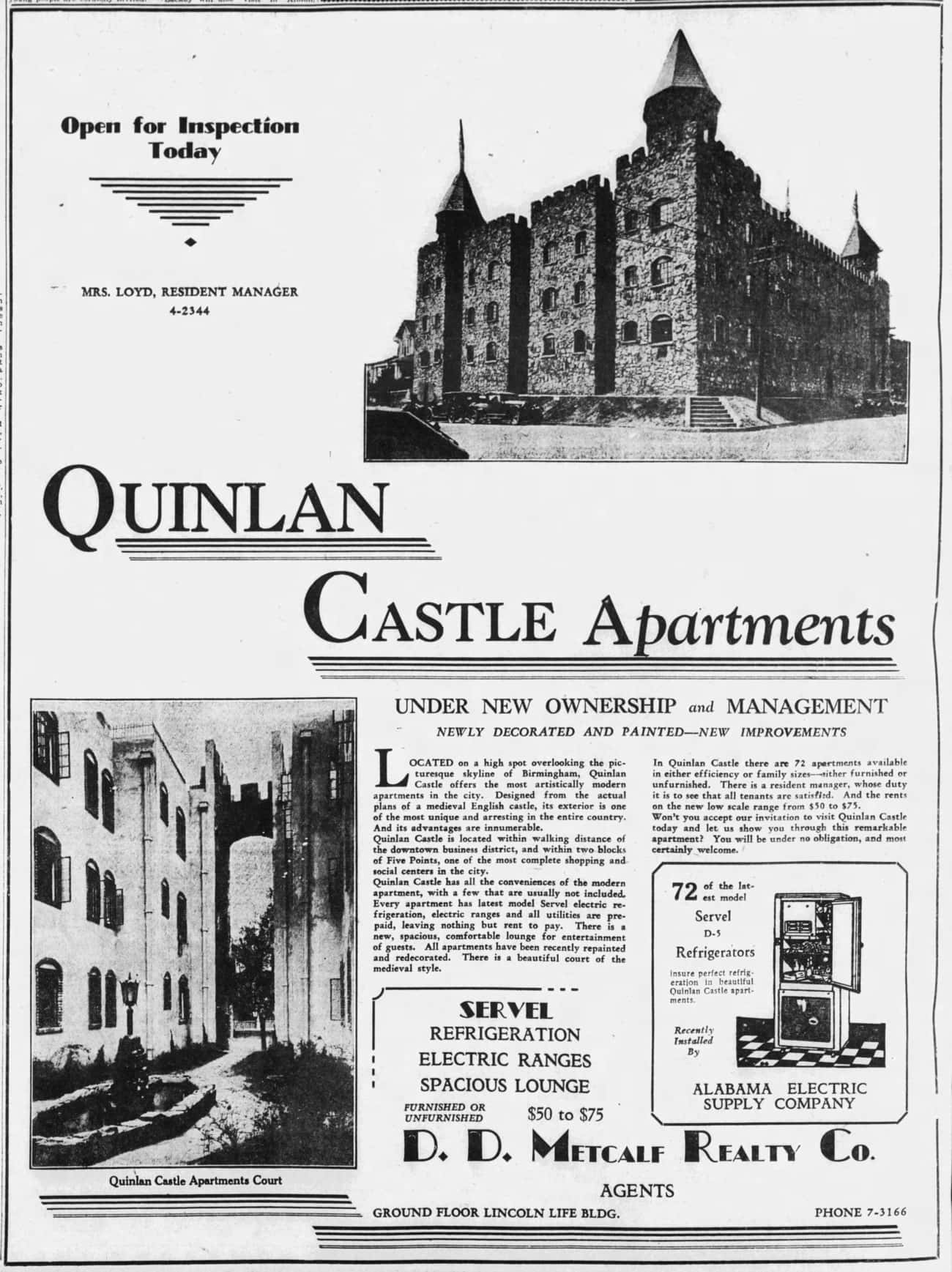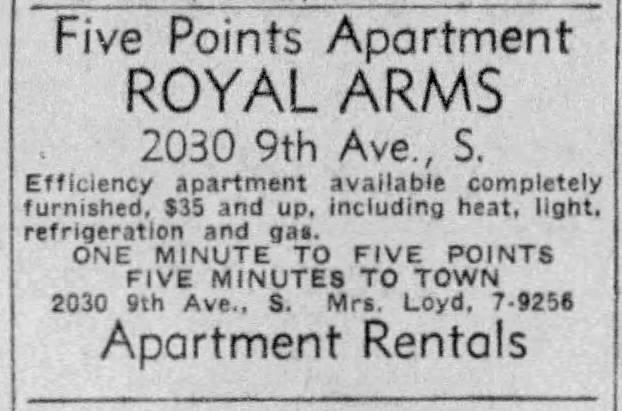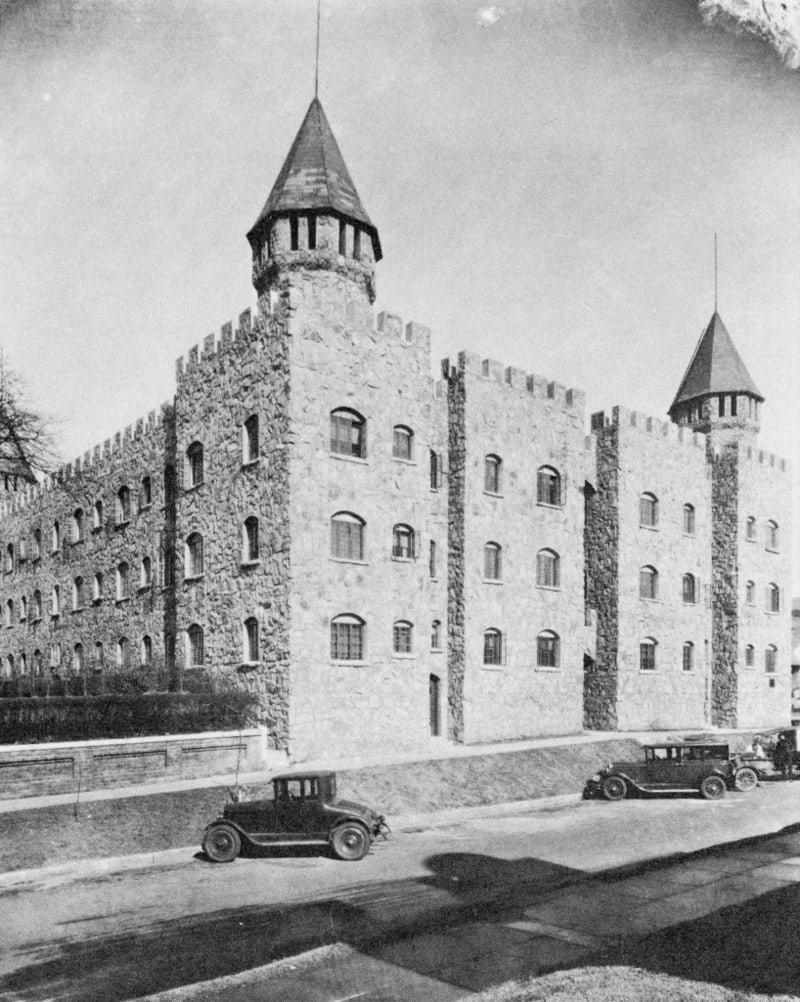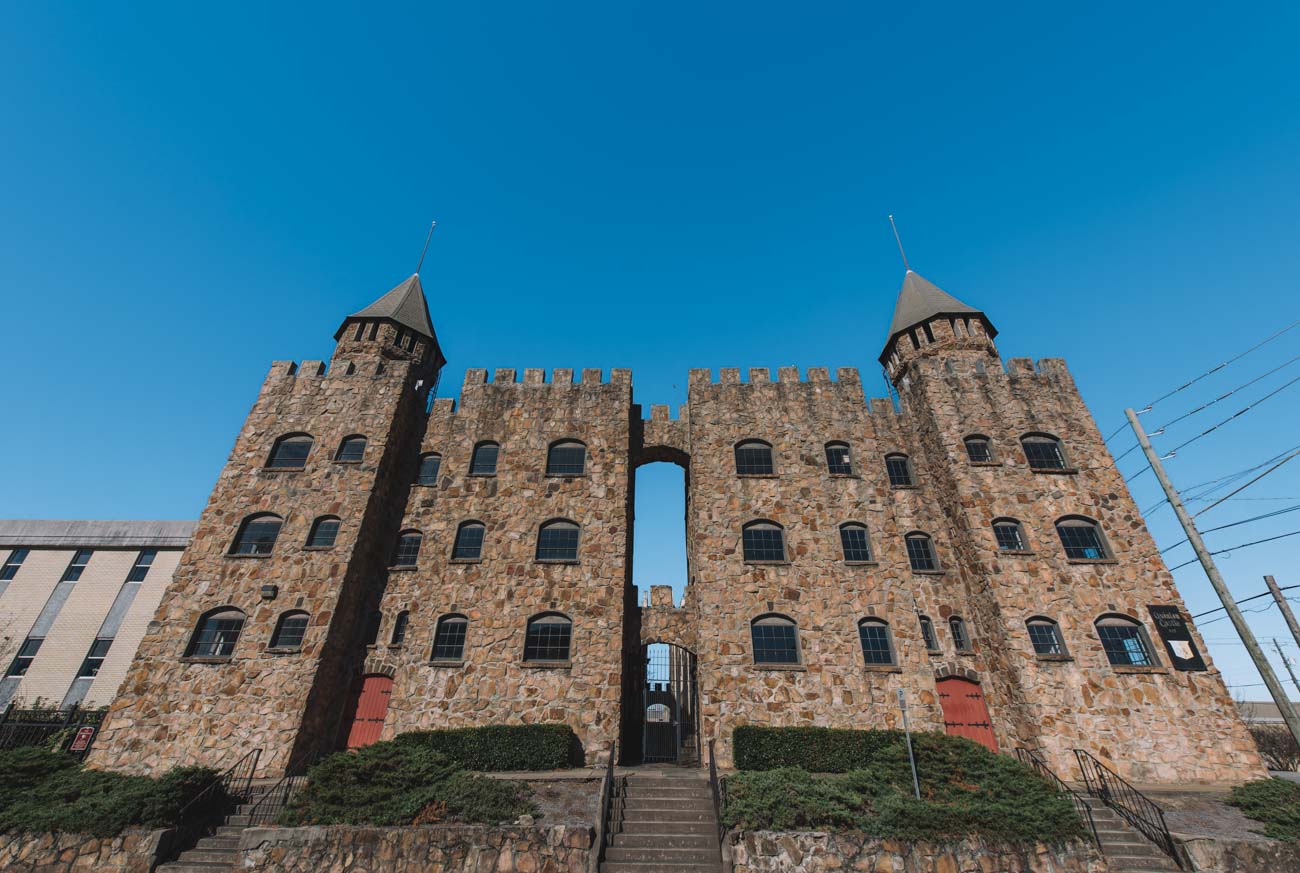| City/Town: • Birmingham |
| Location Class: • Residential |
| Built: • 1927 | Abandoned: • 1997-1998 |
| Status: • Demolished |
| Photojournalist: • David Bulit |
Table of Contents
Quinlan Construction Company
The Quinlan Construction Company was incorporated in April 1926 with Dr. Henry Pierce Hanna, a well-known Birmingham physician who practiced there for 60 years; John Black Ingram Jr., a real estate developer who worked alongside his brother Bert A. Ingram in the Ingram Land Company; William Walton Ford, a businessman who worked alongside his brothers Charles West Ford, Lewis Eastman Ford, and Joseph Mann Ford Jr. in the real estate and insurance business in Birmingham. It was announced that a new three-story, 72-unit apartment building would be constructed on the site of Frank P. Glass’ former residence. The architect of the building is up to debate. C. W. Ford took credit for designing the building when construction was first announced while others have credited the design to two unnamed brothers who were World War I veterans that took inspiration from the castles they saw in France. A 1929 advertisement makes the claim that the building was “designed from the actual plans of a medieval English castle.” Pamela Sterne King and Tom Dolan of the Alabama Historical Commission wrote in the National Register of Historic Places nomination form that William Leslie Welton was the architect with a question mark noted alongside it.
Quinlan Castle
Quinlan Castle formally opened on August 20, 1927, adopting the name from Quinlan Avenue, the former name of 9th Avenue South which honored John Quinlan, Bishop of the Catholic Diocese of Mobile. Bishop Quinlan had purchased the hilltop and surrounding property and planned to make it the site of Birmingham’s first Catholic church. The building was composed of two separate buildings connected by arched gateways and separated by a central courtyard. It was constructed with a reinforced concrete frame, infilled with structural clay tile, and clad with rough sandstone veneer. The exterior featured heavy wood entrance doors with iron hinges, arched windows, a battlemented parapet, and four conical turrets.
Daniel Dunklin Metcalf, doing business as the Metcalf Realty Company, filed lawsuits alleging that H. P. Hanna and the Quinlan Construction Company of breaching a written contract for the exclusive rental agency of the apartments. Wood & Hawkins Inc. were the rental agents when Quinlan first opened. United States Fidelity & Guaranty Company also filed a lawsuit against Hanna claiming he had failed to pay back $50,321 of a bond of $120,000 issued in 1926 for the construction of Quinlan Castle. At the same time, Hanna’s residence in Mountain Brook Estates was in the midst of foreclosure having defaulted on his mortgage of $12,000 from the Prudential Life Insurance Company. In 1929, it was advertised that Quinlan Castle was under the new ownership and management of the Metcalf Realty Company, presumably having won their lawsuits against Hanna and the Quinlan Construction Company. The advertisements also stated that the building had been repainted and refurnished during this time, just three years after its official opening. Throughout the Great Depression, the ownership of the building changed hands a few times for one reason or another.

Communism in Birmingham
On May 26, 1938, the House Committee on Un-American Activities was established to investigate alleged disloyalty and subversive activities on the part of private citizens, public employees, and those organizations suspected of having either fascist or communist ties; although they mainly focused on communism. The committee was headed by Martin Dies Jr. hence it would be known as the Dies Committee in the pre-war years and during World War II.
On April 9, 1940, Birmingham police lieutenant Ollie F. Osborne led a raid on Quinlan Castle which was claimed to have been the headquarters for the Communist Party of Alabama. According to reports, they were there to issue subpoenas to Robert F. Hall, Communist Party secretary for Alabama, and Paul Crouch, aid to the latter. Hall did indeed have an office there, but it was hardly how the news media portrayed it. While police could not locate Hall or Crouch, they found attorney Laurent Brown Frantz in the office of Robert Hall. Police questioned Frantz on their whereabouts and when Frantz told them he had no idea where they were, he was arrested and later subpoenaed by the Dies Committee. Police also found a letter addressed to Robert Hall from Henry C. Hart, a Tennessee Valley Authority (TVA) employee, which suggested a coordinated attempt to fill the ranks of the TVA with communists and to remove anyone that isn’t. This evidence fell in line with the Dies Committee’s belief that communists had infiltrated government agencies, mainly the Works Progress Administration which the TVA was a project of.
In the Journal of the Birmingham Historical Society, Vol. 7 No. 3 & 4 written in 1982, it is stated that the Quinlan Castle name was tarnished after this affair and was renamed Royal Arms in an attempt to remove the stigma of its past associations. While it’s true that Quinlan Castle was renamed Royal Arms, it was already being advertised as such by September 1938, which means the building’s association with communists most likely had no bearing on its name change.

Under city ownership
In 1984, Quinlan Castle was added to the National Register of Historic Places. By this time, the building was operating as an apartment/hotel, meaning you were able to rent an apartment without having to sign a lease. It had also fallen far below the standards it touted when it was first built; the rooms were dingy, portions of the walls and ceiling had water damage, and poor lighting throughout the building. Its ownership fell into the hands of the City of Birmingham in 1993.
City Council member William Bell was running for Jefferson County Commission District 2 and rented a room at the nearby Pickwick Hotel in 1994 in order to establish residency in that district. When this temporary housing arrangement was publicized, he leased an efficiency at Quinlan Castle. Residents of the building hoped that Bell’s presence would lead to improvements in safety and maintenance for the building. The following year, the city spruced up the exterior, added landscaping, renovated the interior, and reopened Quinlan Castle as affordable housing. The city also new signage, one of which was the Quinlan family coat-of-arms depicting “two lions rampant combatant between a mullet surmounted of a crescent in chief and a dexter hand couped at the wrist and erect in base all gules“.
Abandonment
By 1998 however, the building had been abandoned and was added to the Places in Peril list of the Alabama Historical Commission and the Alabama Trust for Historic Preservation. In the following years, the city solicited proposals for its redevelopment, a process slowed by protections applied to the structure by the Alabama Historical Commission which stated that the exterior of the building could not be altered in any way without its approval. Southern Research Institute proposed demolishing the structure for an expansion of their facility but negotiations fell through as Southern Research refused to agree to the preservation of the building’s exterior. In 2006, Southern Research proposed purchasing the building for $400,000 to be used as storage or additional lab space. This potentially involved completely demolishing the interior of the building but preserving the exterior. Again, a deal could not be reached by both parties.
Southern Research returned in 2008 with the same proposal and with Mayor Larry Langford’s recommendation, the city agreed to the deal. The Birmingham City Council voted to approve the deal on August 5, 2008, with Valerie Abbott being the only member to vote no as the agreement explicitly state that the exterior would be preserved. Southern Research closed on the purchase in December and began the process of stabilizing the roof and facade. Exterior windows and fences were replaced and the grounds were cleared of debris and overgrowth. The turrets were also lifted off the corners of the building and set onto the flat part of the roof in order to make repairs. Despite the initial work, the building would remain vacant for the next 13 years.
Demolition
In May 2021, John Carpenter who served as the City of Birmingham’s director of innovation and economic opportunity was selected as Southern Research’s new President and CEO. Barely three weeks into his tenure, the Champlain Towers condominium complex in Miami collapsed suddenly overnight, killing 98 people. Almost immediately, LBYD Engineers Inc. and Williams Blackstone Architects were hired to assess the condition of Quinlan Castle. The report found that the structural beams, floors, walls, stairwells, and roof were corroded or had entirely collapsed in some portions. Lead and asbestos were also discovered. The report also found exposed rebar which was a contributing factor in the collapse of the Champlain Towers. If by chance the structural issues were to be rectified, the interior was not built to withstand the lab equipment Southern Research had planned to install. In November 2021, it was announced that Quinlan Castle would be demolished to be replaced with a new state-of-the-art facility called the Center for Pandemic Resilience that will double its Biosafety Level 3 lab space for research on infectious diseases and expand commercial wet lab space by 60,000 square feet. Despite the opposition to its demolition by the Alabama Historical Commission, Carpenter pointed out that the facade easement put in place in the past was not included in the deed when Southern Research purchased the building from the city. On November 16, 2021, the demolition permit was approved and the demolition of Quinlan Castle began on January 7, 2022.





